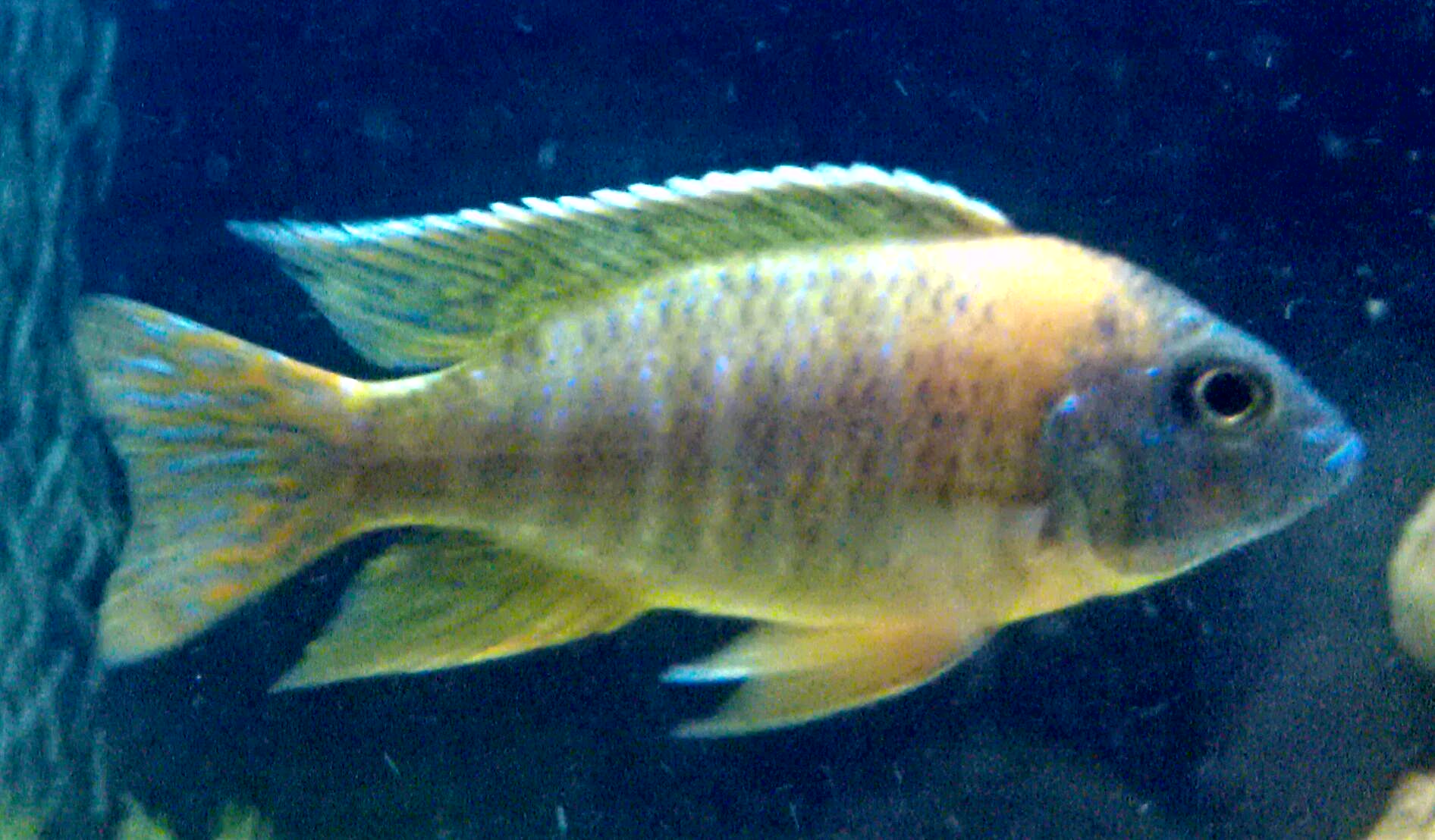 Lake Malawi also known as the lake of stars is one of the great rift lakes in Africa. It is home to several hundred cichlids species that include mbuna, haplochromines (Haps) and aulonocara (peacock). These cichlids are some of the most colorful freshwater species in the world and are only found in Lake Malawi. They are very active, love to greet people and will even beg for food. They are very territorial and have very specific water and dietary needs. This is why they are listed for advanced aquarist at local fish stores. They are especially fascinating to watch When breeding. They will take care of their young for several weeks before they let them go. Some of the other fish that live in Lake Malawi include lungfish, minnows,catfish and eels and probably many more that I don’t even know about.
Lake Malawi also known as the lake of stars is one of the great rift lakes in Africa. It is home to several hundred cichlids species that include mbuna, haplochromines (Haps) and aulonocara (peacock). These cichlids are some of the most colorful freshwater species in the world and are only found in Lake Malawi. They are very active, love to greet people and will even beg for food. They are very territorial and have very specific water and dietary needs. This is why they are listed for advanced aquarist at local fish stores. They are especially fascinating to watch When breeding. They will take care of their young for several weeks before they let them go. Some of the other fish that live in Lake Malawi include lungfish, minnows,catfish and eels and probably many more that I don’t even know about.
The lake consists mostly of sandy bottoms while parts may contain rocks, boulders or gravel. The Haps roam the open waters; where the mbuna stay in their comfort zone, within or close to the rocks where the most aufwuchs grows. The peacock cichlid stay near the bottom of the lake digging in the sand searching for food. In the wild these fish hardly ever or never meet.
The water is very rich in minerals, some salt content and hard water. The water chemistry is in the ranges of:
Ph 7.8-8.6
hardness 160-320ppm or 9-18 DH
temp. 76-85 degrees
salinity 1.000- 1.010
minerals: calcium, magnesium, potassium, nickel, zinc, copper etc..
Now these numbers do change in different parts of the lake and these fish can tolerate a very wide stretch of chemistry.

Picture : Labidochromis, Yellow Fin Mbamba 2″ in size
MBUNAS are the most popular of the African cichlids. Mbunas, pronounced boo-nah, means rock dwellers. They come in a wide range of colors. Most all male and female Mbunas are colorful, with the female having a little bit of a dull or different coloring pattern compared to the male. The male is typically bigger than the female and the only real way to tell them apart is when they get older or by venting. When breeding the male will perform a funny looking dance that looks like they are having a seizure. This is how the male attracts the female into his chosen breeding area, usually a cave or flat surface such as a rock. These mating locations can easily be imitated with a clay pot, stacking rocks to make caves or cichlid stones. Once the female accepts and comes into the breeding area they will circle each other many times while shaking the egg spots on their tails, the female will then lays her eggs. She will then pick them up with her mouth and the male will shake his egg spots on his tail to fertilize the eggs in her mouth.
Most african cichlids are mouthbrooders which means they will carry their fry (babies) in their mouth until its time to let them go, normally 18-36 days. It kinda looks like they’re chewing bubble gum in that process. When feeding in the wild they mostly eat on aufwuchs but in an aquarium fresh vegetables and vegetable fish foods with low protein and fats is the best diet. You need to be very strict with their feeding habits because they are known to get what is called Malawi bloat. Alot of aquarist that have cichlids tanks recommend NLS or Hikari for african cichilds. Almost all African cichlids should be stocked in a 4-5′ aquarium because of their size and aggression. There are very few shell dweller species such as Metriaclima Lanisticola from lake Malawi that a 40 gallon breeder is acceptable.
Picture: Aulonocara “German red” about 2″ in size
PEACOCK cichlids have the most stunning coloration and make great “show off” fish. Their feeding habits in the wild are mostly omnivorous, they eat shrimp, snails, bloodworms and bugs. When breeding, some peacocks lay their eggs, while others are mouthbrooders like the Mbuna. In the wild they are found digging in the sand or in the rocks looking for food. They range in different aggression levels but are peaceful compared to mbunas. This is why they should not be stocked together in an aquarium. If stocked together the peacock would normally show signs of stress and not show as bright of colors.
Above picture: Protomelas Taeniolatus, red empress 2.5-3″
HAPLOCROMINES are open water swimmers and are normally alone. The males are great looking cichlids that have bright color where as the females typically have no color. They usually just stay silver/gray like the fry. Most haps are predators that chase down smaller fish, but some are omnivores.
STOCKING (I can only give you my advice, ideas, opinions or what’s recommended)
When stocking these type of fish it is recommended to not mix different types of cichlids together. This means haps, mbuna or peacock or mix the different lakes. This is because of feeding habits, water requirements, aggression, or tank size. In my opinion, the size of the tank and the aggression levels of the fish should play a large role in deciding if you keep the different types together, as in a 6 foot tank. When they become adults you may need to re-home some but its best to stock with their future in mind. Most aquarists say its best to only stock a few different species but alot of them. The colors of the different fish will make a big change and doing all male tanks will cut back on aggression due to there not being a female to fight over. The reason for overstocking is that it will cut back on the territories that can be claimed.Some aquarists, myself included, will even tell you that every tank is different in every way.
STOCKING MBUNA
When stocking mbunas the minimum required size aquarium for these cichlids is a 55 gallon tank, I prefer to say a 75. If stocking these fish in a 55 gallon my rule is to stay at the smaller end of the mbunas, under 5 inches per fish and stock 16-22 of them with maybe a pleco and some syndontis catfish. It is recommended to not stock mbunas with peacocks or haps. The reason for this is because haps eat smaller fish and some mbunas are small.
STOCKING PEACOCKS
When stocking peacocks, it is recommended not to stock with mbunas because mbunas are more aggressive than peacocks. In my opinion as long as you pick peaceful and maybe some of the less aggressive mbunas you should be fine, but nothing is ever set in stone with africans. Be careful which peacocks you get because some require food that’s not so great for the mbunas. Required tank size is a 4 foot tank. In my opinion when mixing peacocks and mubunas you should have a 6 foot tank.
STOCKING HAPS
When stocking haps they really need a lot of room to swim because their body structure is made for swimming. If stocking with mbunas you’ll really need to watch the food. Also Haps will eat any smaller fish that will fit in its mouth. Keep that in mind when buying your stock. Peacocks and Haps, in my opinion, are not a bad mix just watch the adult sizes and food. I really think these guys should have at least a 6 foot tank or bigger.
STOCKING
With African cichlids it is recommended to overstock a tank. When stocking a new tank you’ll want to do it all in 1 big group or 2-3 big groups to alleviate signs of aggression that may cause stress. You’ll need to move every hiding spot or rock you have in the tank to make sure that the new fish do not try to protect it as their own territory. As they get older, it is a good idea to shift the decorations around at a water change every month or so for that reason as well. If keeping females, it is recommended to have three females to one male. Now in my opinion, if you really want to let them breed I would only pick one of the types of species that you are going to allow to breed and do that breed only in females with the ratio of 1 male to 3 females. This is done so that the male doesnt stress the female by trying to breed too much. Another reason for this is when they are holding their fry they are extremely aggressive towards others and I have seen this end badly for other tank mates.
Before you buy anything, always look up the profiles of the fish to see what their aggression habits, sizes and diets are and please do not impulse buy. I linked a profile thread from aquarium advice that we started for lake Malawi cichlids and you can always try Google as well. Even if you do the research its not a promise that it will work out for you. Just be ready to rehome some if needed due to aggression.
 http://www.aquariumadvice.com/forums/f100/mbuna-peacock-and-hap-pictures-213393.html
http://www.aquariumadvice.com/forums/f100/mbuna-peacock-and-hap-pictures-213393.html
Most of my research was done before I built my tank. So with that being said, below is a list of resources that I used when doing my research.
Books that I’ve read:
African Cichlids, the Pet of Kings! By George M. Fairchild
Cichlid Fish:A Guide To Learn All About Cichlids By Kayla Allen
The Cichlid Natural Grand Experiment by George Barlow
The Owners Guide To A Happy Health Fish CICHLID by Mary E. Sweeney
OTHERS:
Google search
wikipedia
www.thecichlidrecipe.com
www.malawicichlids.com
I also enlisted the help of friends and others from the cichlid forum at www.aquariumadvice.com. They were extremely helpful in making this happen and I would like to thank all of them.



